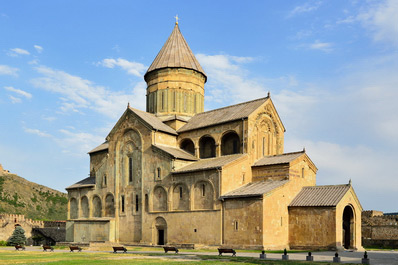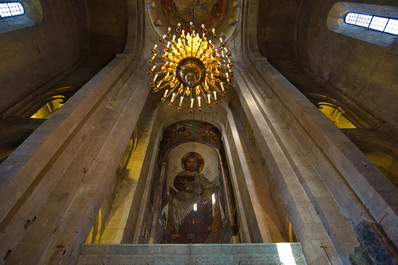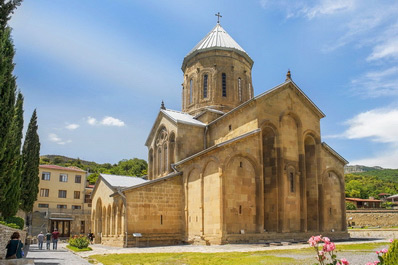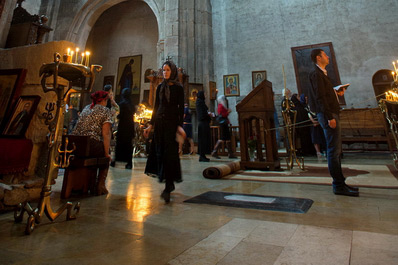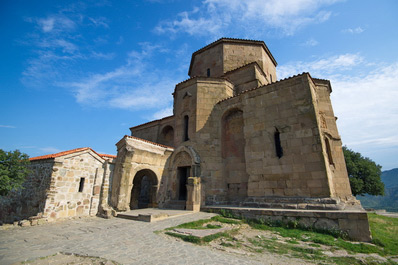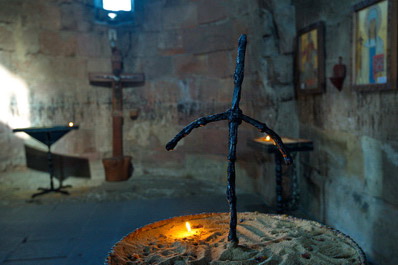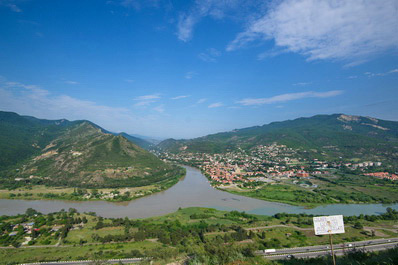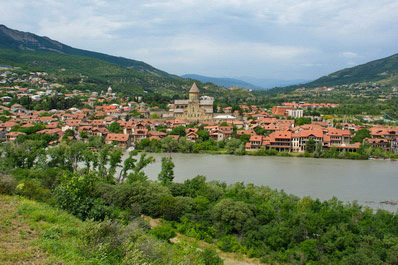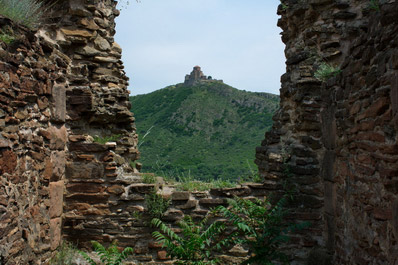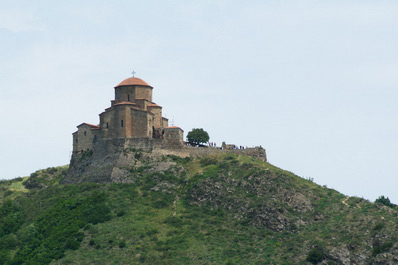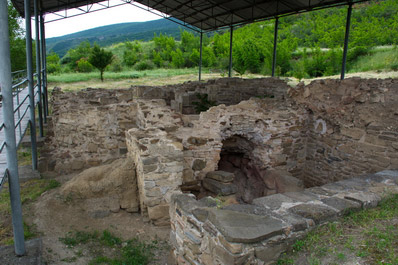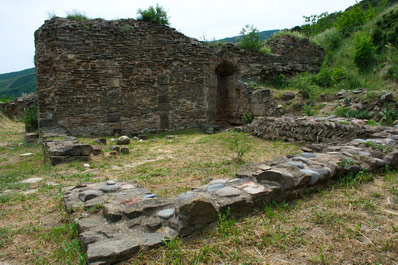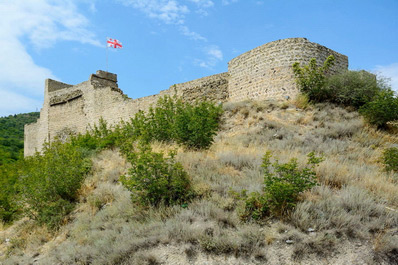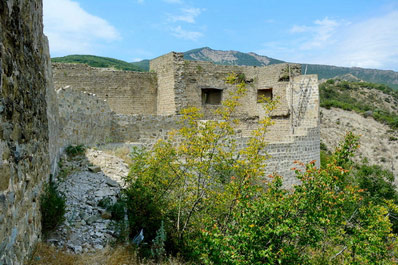Mtskheta, Georgia

Altitude: 460 meters above sea level
Official language: Georgian
Popular languages: Russian
Nationality: Georgians, Russians
Time zone: UTC+4
Phone code: +995 373
Postal code: 33XX
Vehicle code: GEO
Mtskheta is one of Georgia's prime tourist destinations. People travel to this small city, located just 20 kilometers from the center of Tbilisi, to see the ancient historical monuments that connect the country to its glorious past. Interestingly, Mtskheta was the main city of the ancient Georgian kingdom of Iberia and only in the 6th century did the capital status shift to Tbilisi. Mtskheta is home to some of the oldest Georgian temples: Svetitskhoveli, Samtavro, and Jvari, all of which are included in the UNESCO World Heritage List.
Mtskheta is the center of the Mtskheta-Mtianeti region, renowned for its picturesque nature with deep gorges and snow-capped mountain peaks. Most tourists traveling in Georgia opt for a day tour to Mtskheta, and this city truly has a lot to amaze and delight visitors. The cozy cobbled streets, ancient walls of age-old temples, and the stunning nature all around blend harmoniously with each other, enchanting any guest. Additionally, it is in Mtskheta where the Aragvi and Kura (Mtkvari) rivers converge, creating a scenic panorama amid the expansive spaces of the mountain valley. We've compiled a guide to Mtskheta to tell you about the best places and the most interesting attractions of the first Georgian capital.
How to Get to Mtskheta?
Mtskheta is located 20 kilometers from the center of Tbilisi. You can get there by marshrutka (minibus), taxi, or car. Marshrutkas depart from the "Didube" bus station every half hour, with the journey taking about 25 minutes.
Mtskheta's Role in the History of Georgian Christianity
Mtskheta is tied to numerous stories marking the birth of Christian faith in ancient Georgia. According to legend, during the reign of King Mirian III, Iberia followed pagan beliefs, with people worshipping idols led by the god of sky and thunder, Armazi.
At that time (early 4th century), Nina of Cappadocia, later revered as Saint Nino, set out to enlighten pagan Georgia. She was a relative of the Patriarch of Jerusalem and also related to Saint George, the great martyr. After a long and difficult journey, Nina reached Mtskheta and settled near the royal garden. The Christian righteous found shelter in the home of a childless royal gardener and his wife. Through Saint Nino's prayers, the infertile woman was able to conceive.
Nina quickly became well-known: the common people said that the foreigner healed diseases and saved lives. The wife of King Mirian III, Nana, fell severely ill, and no remedy could cure her until Nina healed her. Following this, the queen was baptized, but the king, despite the joyful news of his wife's miraculous healing, was slow to follow her example. Enchanted by the persuasions of pagans, he intended to subject Nina to harsh tortures. When the execution site was prepared, darkness covered the sky, and the king suddenly went blind. Panic and chaos ensued, and the bewildered people cried out to pagan idols to end their suffering, but nothing changed. Then, the terrified crowd turned to the God that Nina had spoken of. The darkness instantly lifted, and the king's sight was restored. Soon convinced of Christianity's truth, King Mirian was baptized, and between 324-326, this religion was established in Georgia.
However, the mountain regions of the country remained unenlightened. Nina then went to the valleys of the Iori and Aragvi rivers to preach the Gospel. Later, she moved to Kakheti and settled in a place called Bodbe, where she eventually died and was buried.
Mtskheta Sights
The main cathedral of the Georgian Orthodox Church in Mtskheta is Svetitskhoveli, founded in the 4th century. The cathedral's name translates from Georgian as "the Living Pillar." The church is consecrated in honor of the twelve apostles. According to tradition, the site of this cathedral is where the Lord's tunic - Jesus Christ's robe, brought to Iberia by a Jew who bought the garment from Roman soldiers - was buried. Where the tunic was buried, a large tree grew, and the Svetitskhoveli Cathedral was later built on this site. Part of that tree remains in the church to this day.
Svetitskhoveli is a true masterpiece of early medieval Georgian church architecture. The current structure has survived from the beginning of the 11th century, although there was a cathedral of the same name - the first Christian church in Georgia - on this site before. The frescoes inside the church, most of which date back to the 14th century, are of particular value. The fresco depicting the Last Judgment is of great interest. It's best to explore the frescoes of the Svetitskhoveli church with a guide who won't miss any details and will explain the symbolic meaning of each image.
The entire church complex is profoundly impressive: the monumentality of the structure harmonizes with its lightness and the special atmosphere of a place of prayer.
Since the 6th century, Georgian rulers have been buried in the Svetitskhoveli church. For example, the burial sites of King Vakhtang I Gorgasali and the last king of Georgia, George XII, are here.
Every year on July 13 and October 14, Svetitskhovloba is celebrated in the Svetitskhoveli church. This is one of the main church festivals, dedicated to the Lord's tunic and the memory of the twelve apostles.
The second, no less important church in Mtskheta, is Samtavro. It is located within the territory of the monastery of the same name. Here lie King Mirian III and Queen Nana, under whom Christianity was established as the state religion of Georgia. Later, the king and queen were canonized as saints. The complex includes the Transfiguration Church and the convent of Saint Nino, which is still active today. Throughout history, Samtavro has suffered from natural disasters and invasions. For example, in 1283, the church's dome collapsed due to an earthquake.
Near the Samtavro Church is the burial site of the revered Georgian saint, Gabriel Samtavro, also known as St. Gabriel (Urghebadze). Thousands of pilgrims from not only Georgia but also other countries visit his grave every year.
After visiting the two main churches of Mtskheta, tourists usually head to another gem of the city - the Jvari Monastery, located on a high hill on the opposite bank of the river. In Georgian, "jvari" means "cross." This name is associated with the legend of Saint Nino and the story of Georgia's conversion to Christianity. Setting out from Cappadocia to Georgia, Nino took with her a cross made from two grapevines, given to her by the Virgin Mary herself. It was this cross that Nino erected on the future site of the Jvari Monastery. Later, after adopting Christianity, King Mirian placed a wooden cross here in the 4th century.
The Jvari Monastery, erected in the 6th century, stands as a monument to the unknown craftsmen who poured their souls into creating this masterpiece. Its exterior facades present a solemn and austere appearance, yet the arches are embellished with intricate patterns and bas-reliefs carved into the stone. The interiors of the monastery evoke a deep sense of awe, with walls adorned with icons, though it lacks frescoes. A prominent wooden cross is placed in the central area of the church, adding to its sanctity.
The views of Mtskheta and its surroundings from Jvari are nothing short of spectacular! The confluence of the Aragvi and Kura (Mtkvari) rivers, against the backdrop of distant blue mountain peaks, inspired the poet Mikhail Lermontov two centuries ago to pen the poem "Mtsyri". In tribute, a monument to Lermontov has been erected at the foot of the hill where Jvari proudly stands.
An intriguing aspect is the distinct hues of the rivers merging at Mtskheta's base, particularly visible on clear, cloudless days. The Aragvi river, originating from the high mountains and flowing from the southern slopes of the main Caucasian ridge, boasts crystal-clear waters. In contrast, the Kura, with its source in Turkey, carries a murkier flow, rich in sand and dense sediments. The point where these two rivers meet presents a striking color demarcation, creating a truly impressive sight.
It's important to remember that Jvari is an active male monastery, housing monks and hosting daily services. Visitors are expected to adhere to dress codes: shorts and short skirts are prohibited; women are required to cover their heads with a scarf. At the monastery's entrance, baskets of long skirts and scarves are available for use, free of charge. These rules also apply to other Georgian churches.
Reaching the Jvari Monastery necessitates the use of a taxi or a personal/rented vehicle, as it lies approximately 13 kilometers from the Svetitskhoveli Cathedral, with no direct bus connection. For those planning to explore Mtskheta as part of a tour group, companies like OrexCA offer visits to Georgia's first capital in comfortable cars accompanied by professional guides.
Beyond ancient temples and monasteries, Mtskheta surprises visitors with the enchanting garden of Mikhail Mamulashvili, a gifted florist and decorator responsible for creating stunning landscape designs. In this magical garden of stones and flowers, seemingly incompatible elements coexist harmoniously: ferns sprouting from a broken wine pitcher, delicate red roses intertwined with beet leaves, amidst scattered fragments of ancient walls, clay shards, curious stone boulders, and mosaic pieces of colorful rocks, all surrounded by lush greenery, grapevines, dense ivy, and fragrant flowers.
Another noteworthy spot in Mtskheta is the Mamaladze family pottery workshop. Founded by Eldar Mamaladze, who mastered the art of clay during the Soviet era, he passed on his life's work to his son Giorgi, a skilled craftsman in his own right. The family maintains a small street-side shop near their production site, located in the city center close to Mtskheta's main churches. Stumbling upon this wonderful place while wandering through the cozy streets of Georgia's first capital, visitors have the unique opportunity to observe the creation of masterpieces and learn the art of pottery under the guidance of the family enterprise's founders.
Attractions Near Mtskheta
Near the Jvari Monastery, one can find the ruins of the ancient Armazi fortress, once a pagan center with worship sites for pre-Christian gods and stone idols. Ancient records mention that this Georgian city was founded in the 3rd century BC. Today, visitors can see the remains of an ancient temple built over two thousand years ago, along with the remnants of baths with a sophisticated water supply and drainage system, and a wine storage with amphora-like vessels called qvevri.
To the north of Mtskheta stands the ancient Bebris Tsikhe fortress, majestically perched atop a steep cliff. While most tourists content themselves with viewing the fortress from the road, those who venture up to its formidable towers are rewarded with stunning views of the Aragvi river valley, tranquility, and the peace of this secluded, uninhabited spot.
Though Mtskheta's attractions may not be as numerous as those in other Georgian cities, they hold immense cultural value for the entire country. To ensure you miss nothing and fully immerse yourself in the city's atmosphere, booking a tour to Mtskheta is recommended. Companies like OrexCA organize memorable trips, ensuring that no detail escapes your attention.

